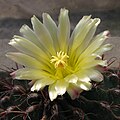Description
Ferocactus hamatacanthus forms to be solitary, usually a globular to oblong shape, and grows up to 60 centimetres (24 in). This plant contains 13 ribs normally, but can sometimes be around 17. These ribs of the cactus are strongly tubercled and are generally 2 centimetres (0.79 in) to 3 centimetres (1.2 in) high. Its aeroles are large and 1 centimetre (0.39 in) to 3 centimetres (1.2 in) apart. There are about 12 radial spines, 5 centimetres (2.0 in) to 7 centimetres (2.8 in) long, that are acicular and terete. However, there are fewer central spines, only 4, that tend to be angled and elongated at around 15 centimetres (5.9 in). One of the central spines is hooked at its apex as well.
This cactus' flowers are large, usually 7 centimetres (2.8 in) to 8 centimetres (3.1 in), and display a yellow color with an inner scarlet color in some forms. This cactus also produces a fruit that is oblong, 2 centimetres (0.79 in) to 5 centimetres (2.0 in) long, fleshy, edible, and a dark brown to drab-color (not red). In addition to these features, its seeds are pitted. [2]
Features
Ferocactus hamatacanthus develops elongated glands, usually 2 centimetres (0.79 in) to 4 centimetres (1.6 in), in the aeroles between the flower and the spines. At first, these glands are soft, but as they mature they become hard and spine-like. Another key feature is the difference of its fruit compared to other species. The fruit of this species is thin and the flesh is very juicy and edible, reminiscent of kiwis in flavor. [2]
Subspecies
Accepted subspecies: [3]
| Image | Name | Distribution |
|---|
 | Ferocactus hamatacanthus subsp. hamatacanthus | New Mexico to Texas and Mexico |
 | Ferocactus hamatacanthus subsp. sinuatus(A.Dietr.) N.P.Taylor | Texas to Mexico |
|
This page is based on this
Wikipedia article Text is available under the
CC BY-SA 4.0 license; additional terms may apply.
Images, videos and audio are available under their respective licenses.








